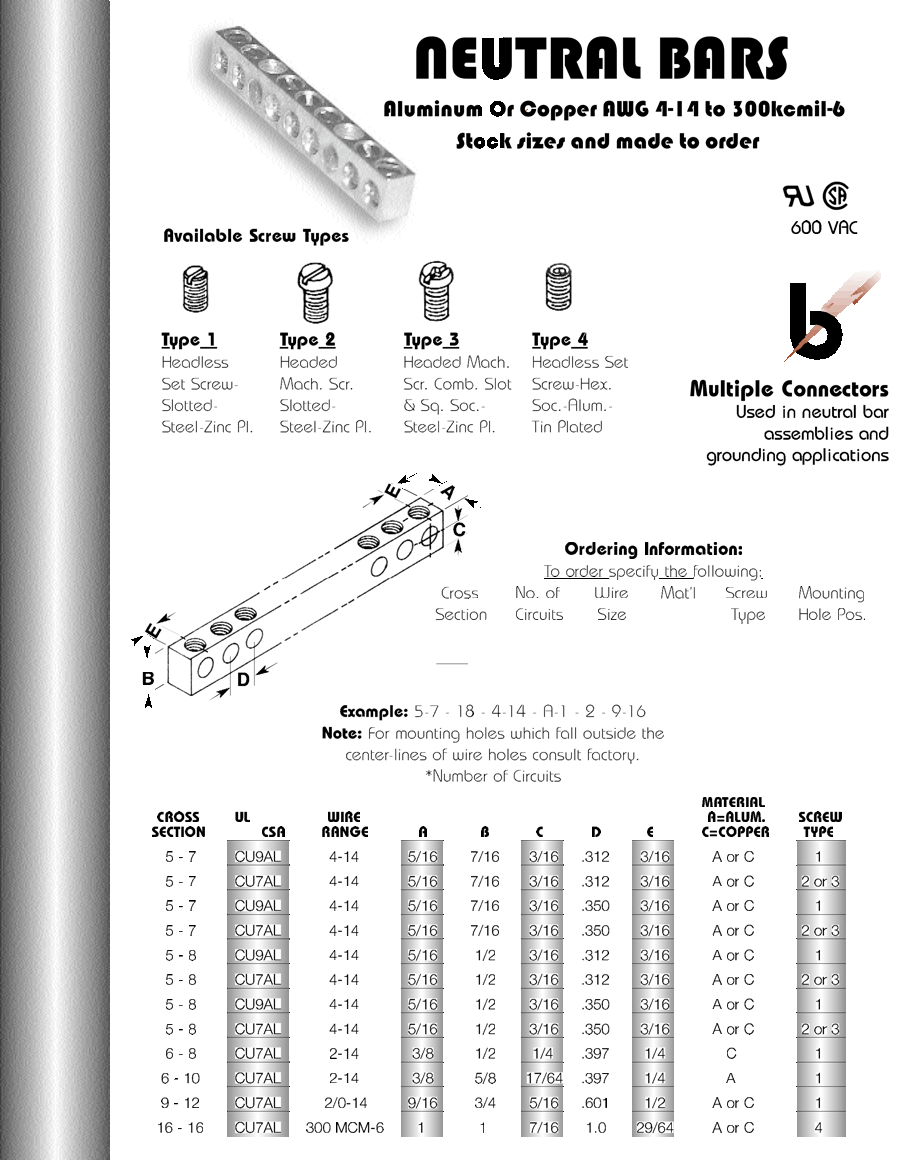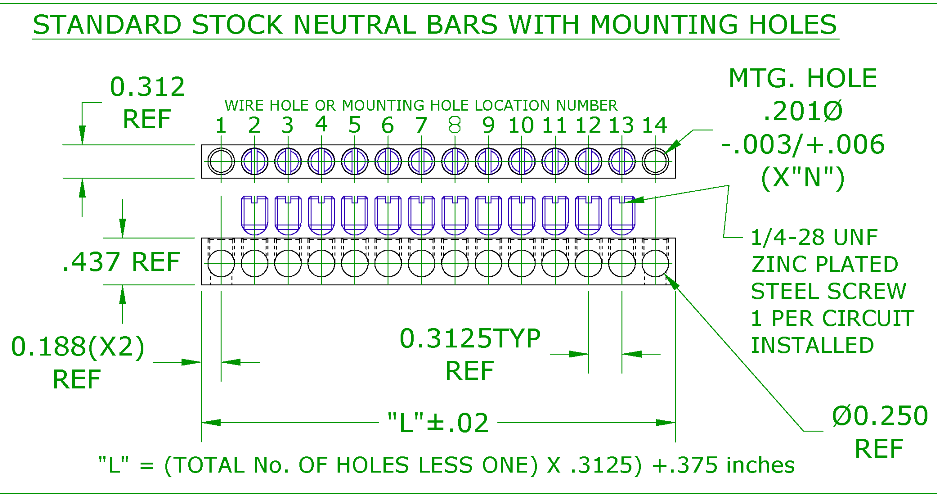To Review Neutral Bars available now from stock,
please click here
To Buy Neutral Bars - please click here
See Below for Chart of All Available Stock and Make-to-Order Wire Sizes and Lengths of Neutral Bars ![]() Click for printable pdf
Click for printable pdf

FAQ about Neutral Bars (Also known as: Earth Bars, Ground Bars)
The selection of and use of neutral bars must be overseen by qualified electrical personal. UL Recognized and CSA certified and marked devices such as neutral bars must approved by UL and CSA in the end use application in addition to the existing UL and CSA approvals for which they have already been tested. It is the customer's responsibility to ensure that all applicable safety standards and codes are met in the end use application for which these devices are used.
What are Neutral Bars? Neutral bars are multiple wire, mechanical compression, wire connection bars used in industrial, commercial and residential electrical panels to terminate the many neutral wires (white in single phase 110V supplies) which return from the various load circuitry in buildings, electrical machinery, control panels, big screen displays, solar panels, and many other applications involving many circuits. Neutral bars are simple mass wire termination devices that allow many wires to be terminated in one place, usually at the main service panel, in a small space and at low cost.
Can they be used with copper or aluminum wire? Dual Rated Neutral Bars made from tin plated aluminum can be used with both copper and aluminum wire (but generally not in mixed the same wire hole). Neutral bars shown here conform to UL486.
Can more than one wire be put in a single wire hole?: Only when the UL wire range and torque instructions for a given UL/CSA catalog number list multiple wires specifically. Generally, multipe wires have to be of the same size and type.
How are the mounting holes located? Neutral Bar mounting holes are used to mount the bar securely. The mounting hole locations vary based on the part number. The holes used for mounting cannot be used for holding a wire so if, for example, there are two mounting holes specified an you want 10 wire holes then a 12 position neutral bar will be needed 10 wire holes and 2 mounting holes. Mounting holes for neutral bars are located along the bar by hole number, counting to include all holes, including those used for mounting.
What are the needs for satisfactory mounting? In a neutral bar with only one mounting hole some means of preventing the neutral bar from rotating when tightening the wire binding screw must be provided in the end use application. This may be as simple as locating the neutral bar next to a step or wall to prevent the turning of the bar when torquing the wire binding screws. Where there are two mounting holes with two mounting screws rotation prevention is normally fully satisfied. The UL and CSA standards which apply to the end use assembly standards are additionally investigated by the user to ensure full compliance.
See below for example of AWG 4-14 series Neutral Bar Dimensions

Why the name "neutral" bars? Neutral is for the "neutral" or apparent "zero" voltage of the return path of typical electrical wiring. The "hot" wire (usually black single phase systems) is at a high potential (voltage) with respect to ground. Power generation is carried out in three phase generators which enables single phase 110 volts, dual phase 220 volts and three phase 440 volts to be readily available for increasingly high power applications. Where the three phases are joined in a "Y" or "Star" format, the three legs are 120 degrees out of phase, and the center of the Y or Star is the "neutral" point. This enables one or two phases to be split off for 110v. and 220v. applications.
So what does it mean to say that the voltage on a neutral bar is "essentially zero"? Is the potential the same as ground (earth) then? Yes and no. Electrical codes dictate that the neutral circuits and the ground circuits be bonded at one point only, at the main entry point. This might mean in the main panel or incoming meter but only in one place and at the "source". So in essence the neutral bar and local wires attached to it are are forced to ground by bonding it to the grounding means in the panel, at that one point.
If the neutral bar is at ground potential, does that mean there is no current flowing in it? No. It is important to note that a neutral bar still carries current even if the voltage at the location of the neutral bar is zero. All of the current used in appliances all over the electrical system go through the neutral bar and back to the current source, the utility line.
Why doesn't the current flow to ground if the two are joined? The output of the utility company's transformer is floating because it is coupled inductively, not by direct conductor connection. The different between the hot (black) wire and the neutral is 110 volts in a single phase U.S. system. In order to make the hot wire 110 volts with respect to ground, the neutral wire has to be "anchored" to ground to make it the zero "reference" voltage. Then one can count on the 110 volts to be 110 volts and the neutral to be zero volts with respect to the ground. By bonding the neutral and ground at the entrance service panel or meter, there is no different in voltage at that point to "drive" current flow into the grounding system. The current flow returns via the low impedence neutral line of the utility company.
What are Neutral Bars made from? In the USA neutral bars are mostly made from tin plated aluminum alloy (aluminum alloy grades 6061, 6005, 6105, 6063 are common). These are tin plated to prevent corrosion and oxidation of the aluminum. Steps must be taken to avoid surface oxidation of aluminum since aluminum oxide is not a good conductor and would create a conductive hot spot if it would be allowed to occur. The use of tin plating and additionally "anti-oxidation" grease is commonly used where tin plated aluminum surfaces wear might occur. Unplated aluminum is widely used in the utility industry but with aluminum wire only. The pressure from mechanical (screw type) wire connections is sufficient to exclude air and oxidation and the rotating screw is self wiping to remove surface oxidation.
Brass Neutral bars are popular in many countries outside of the USA and Canada. Brass alloy can be prone to Stress Corrosion Cracking (SCC) due to its high zinc content. Brass (typically highly machinabel alloy C36000) has a conductivity only about 28% that of copper. Additionally brass has a very high lead content (3.5-4.0% Pb) which is increasing restricted for environmental reasons. Even though the European RoHS initiative permits up to 4% lead in brass as a temporary exemption, the days are numbered for lead in any product to be sold globally.
Aluminum alloy like 6061, by contrast, has no zinc to corrode or lead content and its conductivity is about 43% that of copper (an over 50% improvement in conductivity over brass). On a "cost per amp" basis, aluminum is the lowest cost by far, especially considering that aluminum weighs much less than brass or copper and costs much less per pound than brass or copper. Additionally, aluminum neutral bars are suitable for both copper and aluminum wire (Dual Rated). In the most demanding applications copper is the most desirable but increasingly costly as the copper material and manufacturing cost are both much higher. Aluminum neutral bars are intended for dry locations only where they are protected from exposure to weather and other sources of moisture.
Is aluminum wire reliable for wiring connections? Aluminum wire today is made of a harder alloy than years ago which studies now show enables it to compete in reliability with copper wire. Aluminum wire is only approved for connectors tested for aluminum wire wirhe Dual Rated aluminum connectors such as tin plated aluminum neutral bars. Generally only aluminum wire connectors are compatible with both aluminum and copper wires so offer the most flexibility for the end use.
PHONE 330 562 8983 FAX 330 562 9990
Copyright © 2005-2009 Advancement International Ltd, Aurora Ohio - All Rights Reserved
Advancement International Ltd is a registered company of Ohio, USA. NeutralBars.com and LugsDirect.com are owned and operated by Advancement International Ltd. DUNS # 148692197. REGISTERED WITH CCR, CAGE / NCAGE NUMBER SA6R9, A2 WOMAN OWNED SMALL BUSINESS, NAICS 335931, SIC 3643, MADE IN USA & NAFTA CERTIFICATES AVAILABLE